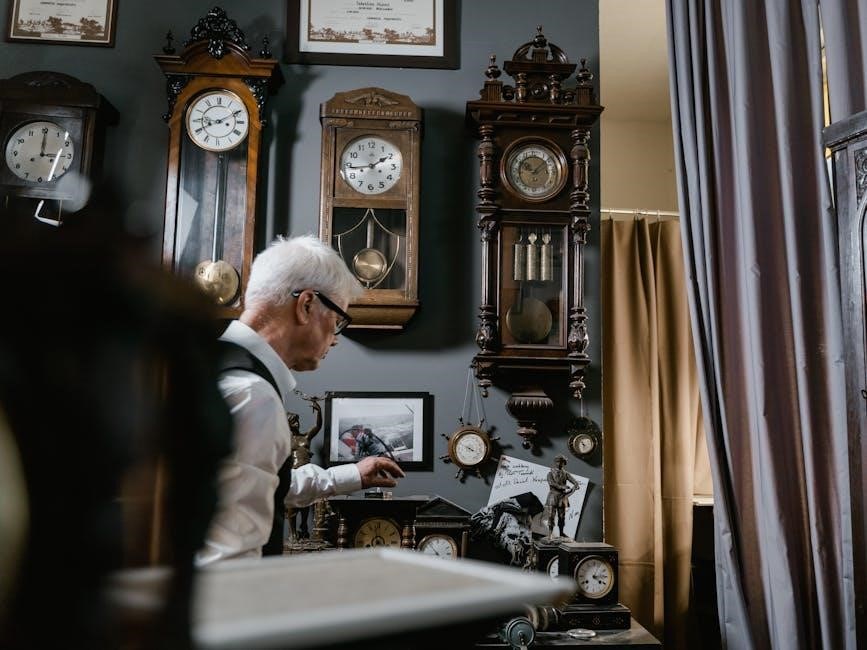Battery Operated Cuckoo Clock Instructions: A Comprehensive Guide

Embark on a journey to master your battery-operated cuckoo clock! This comprehensive guide is designed to walk you through every step, from initial setup to advanced troubleshooting. We’ll explore everything you need to know to keep your clock ticking and the cuckoo calling.
Initial Setup and Battery Installation
Before diving into the enchanting world of your cuckoo clock, a proper initial setup is crucial. Begin by carefully unboxing your clock, ensuring all components are present, including the clock itself, pendulum, weights (if applicable), and any accompanying instructions.
Next, locate the battery compartment, usually found on the back of the clock. Open the compartment and insert the correct type and number of batteries, paying close attention to the polarity (+ and -) markings. Alkaline batteries are highly recommended as they provide a stable power source and longer lifespan.
Once the batteries are installed, ensure they are making good contact. If the battery contacts appear corroded or dirty, gently clean them with a cotton swab dipped in rubbing alcohol. After inserting the batteries, securely close the battery compartment. Now, your clock is ready for the next steps, which include setting the time and adjusting other settings. Remember to save the instruction manual for future reference.
Setting the Time on a Battery Operated Cuckoo Clock
Accurately setting the time is essential for enjoying your cuckoo clock’s delightful features. Locate the time setting knob, usually found on the back of the clock movement.
Gently turn the knob to adjust the minute hand clockwise to the correct time. Avoid turning the minute hand counter-clockwise, as this can damage the clock’s mechanism. If your clock features a cuckoo call or music, you may hear a brief chime as the minute hand passes each hour.
If the clock’s chimes or cuckoo calls are not synchronized with the time, refer to the troubleshooting section of your clock’s manual. Some clocks require a separate synchronization process to align the chimes with the hour.
Once the time is set, double-check its accuracy and make any necessary adjustments. Remember that extreme ambient temperatures can affect a cuckoo clock’s precision over time.
For battery-operated models, if the time on the clock does not correspond to the number of cuckoo calls, consult the manual. With the time accurately set, your clock is ready to bring joy and charm to your space.

Troubleshooting: Cuckoo Bird Not Calling
A silent cuckoo bird can be quite concerning; First, ensure the batteries are fresh and properly installed, as low battery power is a common culprit. Flat batteries may prevent the sound box from functioning. If batteries are new, check the battery contacts for corrosion or loose wires.
Next, verify that the night-off handle isn’t engaged. This handle, often located underneath or on the side of the clock, silences the cuckoo during nighttime hours. Make sure it is in the “on” position for the cuckoo to call.
Inspect the bird’s path for any obstructions. A jammed mechanism can prevent the bird from moving and calling. Gently clear any debris or obstructions that may be blocking the bird’s movement.
If the issue persists, try resetting the clock. Remove the batteries, wait 15 minutes, and then reinstall them. This can sometimes resolve internal glitches.
If none of these steps work, the problem may be a faulty sound module or a more complex mechanical issue. In such cases, consult a qualified clock repair technician.

Troubleshooting: Clock Running Too Fast or Too Slow
If your battery-operated cuckoo clock is losing or gaining time, several factors could be at play. Start by checking the battery power. Weak batteries can cause the clock’s internal mechanism to function erratically, leading to inaccurate timekeeping. Replace the batteries with fresh ones, ensuring they are alkaline for optimal performance and stability.
Extreme ambient temperatures can also affect the clock’s precision. Avoid placing the clock in areas with significant temperature fluctuations.
Ensure the clock is hanging straight and flat against the wall. An uneven surface can interfere with the pendulum’s swing, impacting the clock’s accuracy.
If the issue persists, consider resetting the clock. Remove the batteries for a few minutes, then reinsert them. After reinserting the batteries, carefully set the time.
If these simple fixes don’t resolve the problem, the clock’s internal quartz movement might be malfunctioning. In this scenario, consult a clock repair professional for diagnosis and potential repair or replacement of the movement.
Night Mode and Volume Adjustment
Many battery-operated cuckoo clocks come equipped with a night mode feature, allowing you to silence the cuckoo call during specific hours, typically at night, to avoid disturbances. Locate the night mode switch or button, usually found on the back or side of the clock. This may be indicated by moon symbol.
Adjust the volume of the cuckoo call using the volume control knob, which is also typically located on the back or side of the clock. Turn the knob clockwise to increase the volume and counterclockwise to decrease it.
Some clocks offer automatic night mode settings, utilizing a light sensor to detect when the room is dark and automatically silencing the cuckoo call. Ensure the light sensor is not obstructed for this feature to function correctly. On some models, this sensor may be connected to the battery box and have a wire that could become loose.
If your clock’s night mode or volume adjustment is not working, check the battery power and ensure the switches and knobs are clean and functioning properly.
Battery Type and Replacement
Battery-operated cuckoo clocks typically require C-size batteries, but always refer to your clock’s manual for the exact battery type specification. It is important to use alkaline batteries, as they provide a more stable power source and last longer than standard batteries. Avoid mixing old and new batteries, as this can reduce performance and potentially damage the clock mechanism.
To replace the batteries, first, open the battery compartment, usually located on the back of the clock. Remove the old batteries and insert the new ones, ensuring they are inserted with the correct polarity, as indicated by the markings in the compartment.
When replacing batteries, it’s a good idea to clean the battery contacts with a dry cloth to ensure a good connection. If the clock isn’t functioning well, it may have corrosion. Replace all batteries at the same time to maintain optimal performance. Dispose of used batteries properly.

Addressing Common Issues: Bird Door Malfunctions
One of the most charming features of a cuckoo clock is the bird emerging from its door, but sometimes this mechanism can malfunction. If the bird door doesn’t open or close correctly, there are several things you can check.
First, ensure that there are no obstructions blocking the door’s path. Small objects or debris can prevent the door from moving freely. Secondly, check the batteries. Low battery power can sometimes cause the door mechanism to fail. Replace the batteries with fresh ones to see if that resolves the issue.
Inspect the hinges of the bird door for any signs of damage or stiffness. A little lubricant, such as WD-40 or silicon spray, can help loosen stiff hinges. If the door is misaligned, try gently adjusting it to ensure it aligns properly with the opening. If these steps don’t fix the problem, consult a clock repair professional.
Adjusting the Pendulum for Accuracy
A cuckoo clock’s pendulum swings back and forth, regulating the clock’s timekeeping. If your clock is running too fast or too slow, adjusting the pendulum can help improve its accuracy.
To adjust the pendulum, you’ll typically find a small weight or leaf that can be moved up or down. Moving the weight up shortens the effective length of the pendulum, causing the clock to run faster. Conversely, moving the weight down lengthens the pendulum, causing the clock to run slower.
Make small adjustments and observe the clock’s performance over a day or two to see if the adjustment was effective. You may need to repeat this process several times to achieve the desired accuracy. Ensure the clock is hanging straight on the wall, as an uneven surface can also affect the pendulum’s swing and the clock’s timekeeping.
Maintenance Tips for Longevity
To ensure your battery-operated cuckoo clock lasts for years to come, regular maintenance is essential. Start by cleaning the clock’s exterior regularly with a soft, dry cloth to remove dust and grime. Avoid using harsh chemicals or abrasive cleaners, as these can damage the clock’s finish.
Periodically check the battery compartment for any signs of corrosion. If you find corrosion, carefully clean the contacts with a cotton swab dipped in white vinegar or a specialized contact cleaner. Ensure the clock is placed in a stable environment, away from extreme temperatures or humidity, which can affect its performance.
When replacing batteries, always use the recommended type and voltage, and avoid mixing old and new batteries. If you plan to store the clock for an extended period, remove the batteries to prevent leakage and corrosion. By following these simple maintenance tips, you can keep your cuckoo clock in top condition and enjoy its charming presence for many years.
